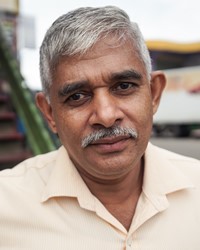Sinhalese in Italy

Photo Source:
Copyrighted © 2025
The Road Provides - Shutterstock All rights reserved. Used with permission |
Send Joshua Project a map of this people group.
|
| People Name: | Sinhalese |
| Country: | Italy |
| 10/40 Window: | No |
| Population: | 59,000 |
| World Population: | 714,500 |
| Primary Language: | Sinhala |
| Primary Religion: | Buddhism |
| Christian Adherents: | 2.00 % |
| Evangelicals: | 1.00 % |
| Scripture: | Complete Bible |
| Ministry Resources: | Yes |
| Jesus Film: | Yes |
| Audio Recordings: | Yes |
| People Cluster: | South Asia Buddhist |
| Affinity Bloc: | South Asian Peoples |
| Progress Level: |
|
Introduction / History
Sri Lanka has a history that goes back thousands of years. Among the people who have been on that South Asian island the longest are the Sinhalese. Today the Sinhalese are the majority people, but the Tamils are a close second in terms of population.
In the late 1970s Sinhalese people began to migrate to Italy for employment opportunities as domestic workers. Others worked in call centers or restaurants. In the late 1970s, Roman Catholic Sinhalese arrived in Italy to work in homes for the aged. In the early 1980s others came to Italy to work for Italian entrepreneurs. Most of these people were not expecting to remain in Italy for more than a couple of years. In 1996 the Dini Decree made it easier for Sinhalese workers to bring their families to Italy. At this point the Sinhalese were more likely to settle in this European country.
Where Are they Located?
Most Sinhalese in Italy are located in Lombardia, Milan, Lazio, Rome, and Naples. Those in southern Italy are likely to live in Palermo, Messina, and Catania.
What Are Their Lives Like?
The Sinhalese in Italy are primarily doing menial work, so they do not have much money. By working as domestic workers and such, they probably work long hours with little pay. Typically Sinhalese people send their children to English speaking countries for education, and consider the Italian schools to be substandard.
What Are Their Beliefs?
The vast majority of Sinhalese people in Italy are Theravada Buddhists. There are few Buddhist places of worship in Italy, and because of their work life, few Sinhalese people have the time to do much more than home-based Buddhist rituals. The places of Buddhist worship in Italy are usually funded and administered by Japanese Buddhists, so it's possible these places feel foreign to the Sinhalese. The Japanese are not Theravada Buddhists like the Sri Lankan Sinhalese. Two percent of the Sinhalese are either Protestant or Roman Catholic.
What Are Their Needs?
The Sinhalese need opportunities for better education and job opportunities. They need training for higher paying jobs.
They also need to have the chance to respond to the gospel in a practical way.
Prayer Points
Pray for missionaries who will teach the Sinhalese people job skills so they can earn a better living.
Pray for the Holy Spirit to move among the Sinhalese in such a way that they will seek and find the only Savior.
Pray for someone to distribute gospel materials in Sinhala, their language.
Pray for a disciple-making movement among Sinhalese Buddhists in Italy.